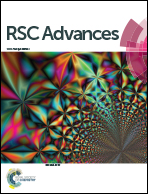Glycidylmethacrylate based resin functionalized with graphene oxide for column preconcentration and trace determination of Cd(ii) and Ni(ii) in environmental and food samples†
Abstract
A novel solid phase extractant was synthesized by the immobilization of graphene oxide onto a glycidylmethacrylate matrix via coupling through the diethylenetriamine spacer arm and explored for the development of a column method for the preconcentration and flame atomic absorption spectrometric determination of Ni(II) and Cd(II) in environmental and food samples. The sorbent was characterized by Fourier transform infrared spectroscopy, elemental analysis, scanning electron microscopy, transmission electron microscopy, energy dispersive X-ray analysis and 13C NMR. The SPE method was optimized by varying experimental parameters such as pH, time, flow rate and elution. Under the optimized conditions the sorbent shows preconcentration factors of 180, 160 and detection limits of 0.23 and 0.06 μg L−1 for Ni(II) and Cd(II), respectively. The absence of systematic and constant errors in the developed method was confirmed by analysis of a Standard Reference Material and recovery experiments (>95% recovery with <5% RSD) after spiking of a known amount of analyte in real samples.


 Please wait while we load your content...
Please wait while we load your content...